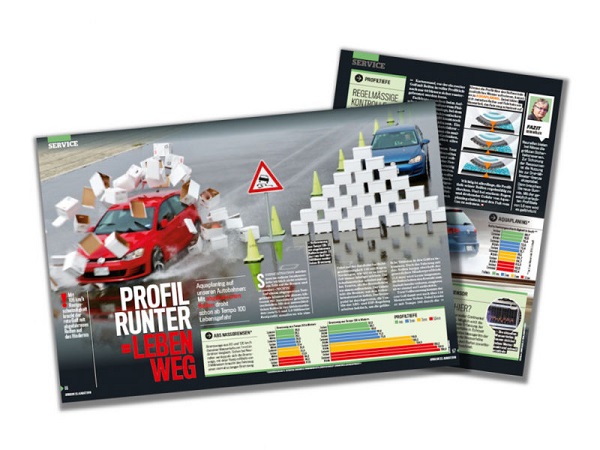September 17, 2019 |
‘One-sided, unrepresentative, unrealistic’ – Michelin criticises Auto Bild tyre test
As was reported in July, progress is being made at European and international levels towards deciding on a wet grip test for worn tyres. Michelin actively supports this development and claims that driving on tyres to the legal tread depth of 1.6mm can be completely safe. The tyre maker is therefore critical of a magazine test that suggests this isn’t the case at all.
The 22 August issue of Auto Bild featured a test of three premium tyres and their respective braking distances and aquaplaning speeds when new, as well as with 5mm, 3mm and 1.6mm of tread remaining. The test report began with the dramatic headline ‘Tread Low = Life Gone’ (Profil Runter = Leben Weg) and the comment from Auto Bild tester Dierk Möller that a risk of “mortal danger” existed even when driving at 100km/h on worn tyres.
Möller evaluated three tyres, the Continental Premium Contact 6, the Goodyear Eagle F1 Asymmetric 3 and the Michelin Primacy 4, all in the 225/45 R17 size. Stopping distance was tested from 80km/h and 120km/h on a surface covered with 1mm water, as well as the speed at which aquaplaning commenced on a surface covered with 9mm of water.

The average stopping distance from 80km/h was just over ten metres longer for the 1.6mm tyres than for the new products, but the difference was much greater at 120km/h. Auto Bild reported that the stopping distance for the 1.6mm tyres was on average almost 96 metres longer. During the aquaplaning test the car fitted with 1.6mm tyres floated at an average speed of 62.7km/h; the car fitted with new tyres at an average of 78.5km/h.
Dierk Möller concluded that “new tyres offer the largest safety margin in the wet.” He added: “Usage down to a 3mm limit is acceptable in order to conserve resources. Then you need new rubber. Danger arises with the legally allowed tread depth of 1.6mm.”
‘Unrealistic’ conditions
Michelin’s Pierre Robert hasn’t taken this criticism of worn tyres lying down. The vice president of research refers to the Auto Bild article as “one-sided” and “unrepresentative”, commenting that the tests involved reflected an “unrealistic driving situation.”
A key claim made under Michelin’s Long-Lasting Performance (LLP) strategy is that good performance when worn is a matter of design. The tyre maker observed that, at present, just a handful of premium manufacturers prioritised lifetime performance when designing tyres.
Robert noted that Auto Bild tests from recent years had “revealed particularly large differences” between premium manufacturers and other tyre manufacturers. “This was unfortunately not taken into consideration for this article,” he added. “As only premium tyres were compared, the analysis of the worn tyres’ performance is one-sided.”
Auto Bild tested wet braking distances with 1mm of water on the road surface, and the publication conceded that water levels on main roads and motorways only exceeded this depth “in rare cases”, even during heavy rainfall. The publication likely chose a depth of 1mm as this is the level set out in the UN/ECE R117 tyre test standard and is also used throughout the tyre industry as the wet braking reference value when developing new tyres.
Robert agrees that actually encountering 1mm of water on the road whilst driving is a “rare, exceptional situation”, as more than 100 litres of rain per hour would first need to fall. Therefore, Robert believes, and is supported here by accident research information used as a reference for LLP, that the driving situation described by Auto Bild, a speed of 120km/h despite inadequate visibility and uncertain road conditions, isn’t a “realistic everyday situation.”
As for the aquaplaning test, Auto Bild reported that it tested with a water depth of 9mm, which is, by anyone’s measure, a lot of water.
Summing up, Pierre Robert reiterated that Michelin views the driving situation described by Auto Bild as unrealistic. “We advise every motorist against this. Driving can be safe even in the rain with good tyres and an appropriate driving style. My impression is that this article hasn’t made this clear enough.” He pointed out that in the described driving situation, the driver would have noticed the beginnings of aquaplaning long before needing to perform an emergency braking manoeuvre. “Furthermore, we question whether, in the described driving situation, the tyres only lose contact with the road when the brakes are applied.”
Newer technologies already available
One thing the Auto Bild test showed is that the Goodyear and Continental tyres demonstrated the LLP strategy slightly better than Michelin itself; at a tread depth of 1.6mm, both had shorter stopping distances from 80km/h and 120km/h. Pierre Robert viewed this as a positive result: “The article supports our LLP argument that tyre performance at decreasing tread depths is a decision made by manufacturers. We are pleased that other premium manufacturers are also considering the findings of Long-Lasting Performance during the (tyre) development process.”
Regarding the test’s specific results, Robert pointed out that the Primacy 4 had been available since 2017. “We already have models with newer technologies on the market in 2019,” he stated. “In addition, results with worn tyres, in this instance machine buffed, don’t reveal anything about total mileage until the stated remaining tread depth is reached. Environmental impact is also an important aspect of Michelin’s Long-Lasting Performance.”

